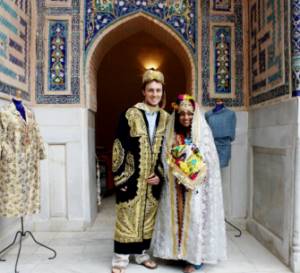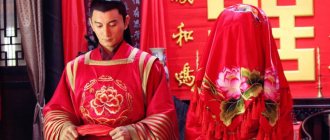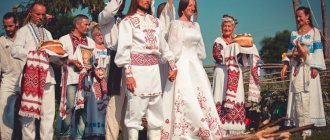An Uzbek wedding is a vibrant event with a lot of national treats, cheerful music and interesting rituals. The wedding customs of this people were formed and consolidated over many centuries, and today Uzbeks continue to honor and perform them.
Like a wedding in Azerbaijan, an Uzbek wedding is considered a special event for parents and newlyweds, which is why they prepare for it long and carefully. What is she? Svadbaholik.ru will be happy to tell you about this wonderful celebration.
Matchmaking and engagement
Often, relatives begin to look for a bride for a young man as soon as he turns 18. Sometimes searches drag on for a long time. When choosing a bride for their son, parents first of all pay attention to:
- social status,
- the level of education,
- upbringing,
- housekeeping skills.
If the bride meets all the requirements, the first stage of marriage in Uzbekistan begins - matchmaking. To do this, matchmakers are sent to the girl’s house. The bride's relatives greet them cordially and generously treat them. On the first visit, matchmakers have the opportunity to evaluate the bride, her upbringing, and ability to communicate with guests. Uzbek wedding traditions require three visits by matchmakers to obtain consent for marriage.
As a sign of agreement, representatives of the two families break the cake. Then the engagement is celebrated at the girl's house. The bride's parents arrange a celebration, generously setting the table, and the groom's relatives present the girl with sweets, fabrics and money.
Traditional engagement in Uzbekistan fatiha-tui
The groom's parents collect information about their future daughter-in-law through friends and acquaintances. They are usually interested in:
- Social status of the candidate's family.
- Level of upbringing and education.
- Ability to manage a household.
After a candidate has been found and approved, the main matchmaking procedure takes place called Fatiha-Tui. To do this, matchmakers are invited and sent to the house of the girl they like. Their task is to draw a conclusion from the first impression about the bride and her family. Matchmakers traditionally use a keen eye to notice the level of cleanliness in the house, and also observe the ability of the chosen candidate to care for guests.
The matchmaker is greeted with an oriental cordiality, offered tea in the room, entertained with conversations, but according to established tradition, consent to the marriage is not given the first time. The parties, as a rule, come to an agreement no earlier than the third time. As an agreement, the bride's side breaks the cake. The Fatiha-Tui engagement is celebrated on a grand scale: on this day, the groom’s parents give the bride money, beautiful fabrics, sweets and meat in every possible way.
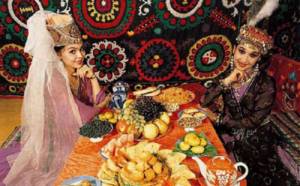
Traditional pilaf
Preparing morning pilaf is an important ritual with which the wedding begins (in Uzbek it is called “Nakhor oshi”). Only men should serve food on the table. The event can last several hours. The cheerful feast is accompanied by traditional music, songs and dances. Women are not present during this action. They perform the ceremony separately. It is called “Khotin oshi”, which translates as “pilaf for women”.
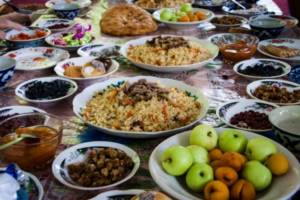
Features of marriage in Uzbekistan
According to Uzbek traditions, the wedding begins with morning pilaf at the bride's house . The male part of the bride's relatives begins to prepare the festive pilaf before morning prayer. This national dish has many recipes.
Future wedding cooks need to agree on the pilaf recipe in advance with relatives and neighbors.
After morning prayer, the men invited to the wedding sit down at the tables, and the relatives who cooked treat them with cooked pilaf. The feast lasts approximately two hours.
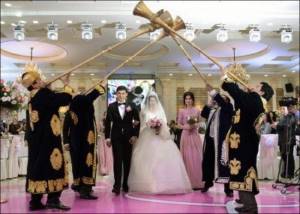
Its peculiarity is that only men take part in it and only men serve the guests. Cooks need to correctly calculate the start time of cooking so that the pilaf is ready on time.
The groom wears a festive national robe to the wedding, donated by the family of his future wife. Previously, brides wore national attire richly decorated with embroidery to the ceremony, but now wedding dresses are in European style.
The bride's face is always covered with a veil to protect her from the evil eye.
The wedding ceremony is performed by a guest imam. First, the ancient ritual “Nikokh-tui” is performed. During it, the bride promises to always remain faithful to her husband and wait for his return home. Young people drink water from the same container.
Then the imam says special prayers tying the bride and groom in marriage. The imam blesses the newlyweds' marriage at the registry office.
The wedding banquet is organized on a special scale. The following dishes must be on the tables:
- tui palov - a type of pilaf that is prepared for weddings;
- manti is a traditional holiday treat.
The feast is not limited to these dishes. The tables are filled with a variety of treats so that the young people can live happily and prosperously. There is a fun atmosphere at the wedding. The guests rejoice, congratulate the newlyweds, treat themselves to numerous dishes, sing and dance.
Uzbek wedding dresses
Despite the fact that today Uzbek brides can afford to wear wedding dresses according to European fashion, many still continue to adhere to traditions and prefer national costumes.
To sew a wedding dress, a type of silk fabric is used - khan-atlas. A velvet camisole, hand-embroidered with gold threads, is worn over the dress.
Uzbeks believe that jewelry is the best amulet against the evil eye. Therefore, the Uzbek bride tries to wear as many rings and bracelets as possible. This has some similarities with the traditions of a Tamil wedding.
An important detail of the bride’s image is the “tiplya-kosh”. This is a type of kokoshnik. It is richly decorated with embroidery and pendants. When the bride comes out to the groom, a “bolimpush” is held above her head. This is a large embroidered cloth, symbolizing patronage in marriage.
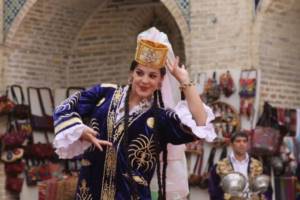
The traditional wedding attire for the groom - sarpo - is bought by the bride's parents. In different regions of the country, Uzbek wedding attire may differ, but it must look bright and rich. In the photo below you can see examples of Uzbek wedding dresses for newlyweds.

An Uzbek wedding begins with the search for a bride
What is a wedding without young people, and the main task is to find a suitable bride for the groom. In traditional Uzbek families, this responsible task falls on the shoulders of the parents and older relatives of the young guy. First, it is found out what kind of girls are around, and the one suitable for a particular family is selected from among them. Not only her age is taken into account, but also her social status, character and level of upbringing. Often relatives go to educational institutions where there are many girls, choosing medical, culinary or pedagogical technical schools.
In some families, to this day the opinion of the young themselves is not taken into account, but over time, changes have nevertheless occurred. So, previously, the bride and groom could see each other for the first time only on their wedding day. However, now they are allowed to communicate before the celebration. A more humane position is when the meeting takes place before the official matchmaking; in this case, the bride and groom can express their opinion to their parents and not agree to further communication with each other.
In modern families, they can consider as a bride the girl who is proposed by the groom himself. He may know her. However, the main word remains with the parents.
Fortunately, the tradition of “Beshik Kerti”, when the conspiracy took place at a younger age, has sunk into oblivion. Relatives or good friends agreed on the wedding of their children soon after their birth. Even in those distant times, it happened that the bride, growing up, ran away from home, not wanting to marry an unloved person.
Wedding in Tashkent - a grand feast
According to ancient customs, the wedding takes place in the groom's house and at his expense. But modern Uzbeks living in Tashkent can deviate from traditions, for example, share expenses or hold a celebration in a restaurant. But in any case, Uzbek weddings are distinguished by luxury and a large number of guests. Celebrations for 300-400 people are often held in Tashkent.
Traditionally, upon the arrival of the bride, a white path is laid out, along which she will enter the groom's house or place of celebration. Guests shower the bride with petals, sweets and money, wishing her a happy family life. Nowadays newlyweds often go out together.
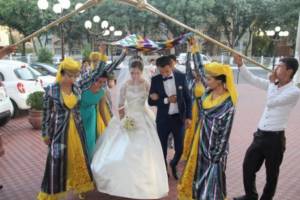
During the celebration, the newlyweds are seated in a wedding hut. A traditional tablecloth, dastarkhan, is laid out in front of them. Placing a variety of treats and sweets on the tablecloth is a ritual of attracting wealth and well-being to a new family.
A wedding in Tashkent is not complete without another important custom. Newlyweds should definitely eat honey during the holiday. This will provide them with a sweet and happy life.
National music and dances are a mandatory element of the entertainment program, as is the case with weddings among different peoples living in the eastern part of the continent.
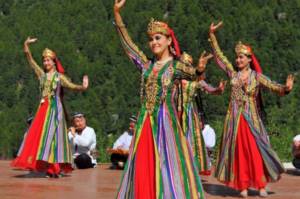
Celebration
The wedding itself begins in full after the bride, along with her dowry, crosses the threshold of her new home. The wedding feast used to always take place in the house of the groom's parents, but these days it can also take place in a restaurant.
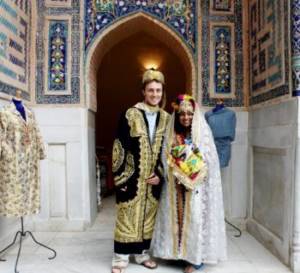
The young woman is greeted with a white path, along which she must approach her new family, bow to them, performing kelin salom, and they, in return, present their acquired daughter with valuable gifts and money. After family members have given each other due welcome and respect, the wedding feast begins. There are always a lot of guests: relatives, friends, acquaintances, neighbors; weddings often number up to several hundred people, and on special occasions – up to a thousand.
The tables are laden with food. The traditional dishes of this day are a special “wedding” version of pilaf (tui palov), manti, noodles with horse meat, sausages, cheeses, vegetables, and sweets. During the celebration, the husband personally puts on his wife the gifts prepared for her, wrist watches and bracelets. The songs and dances do not subside until late in the evening. The celebration ends with the bride and groom leaving the feast and being separated for a short time.
The new wife will be met by her closest friend, who will help her take off her festive clothes and leave the girl behind a special curtain (gushanga).
Then the husband should come in the company of friends, he gives Yanga a ransom and, saying goodbye to his entourage, goes to his wife.
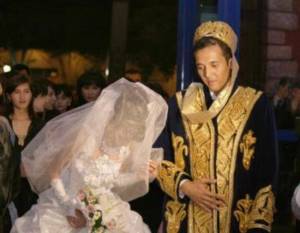
Relatives from his side and the young wife’s side gather in the new husband’s house, where she will greet them as a hostess with bows. These movements are special; they are learned long before the wedding.
Actually, kelin is a daughter-in-law, and salom is a bow, so from the name of the day it is clear what the girl has to do. Everyone always brings her gifts, and she can give her a towel, handkerchief or other item if she wishes. It is believed that a gift from Kelin brings good luck. Honor and bows are due to everyone who comes, regardless of his age, gender and social status. The fun continues.
A man may not be at home at this time, but eat pilaf with his friends.
The wedding night
Representatives of eastern countries treat the sacrament of the first wedding night with special trepidation. An Uzbek wedding in Tashkent is no exception. The groom, according to custom, must “buy” the bride from her aunt or close friend - yangi. This happens as follows.
At the end of the celebration, the bride and groom, holding hands, leave the wedding hut, but are separated for some time. The groom stays with his friends, while the yanga accompanies the bride to the bedroom, helps her change clothes and hides her behind a screen - gushanga. Only then does the groom come with his friends. In order to be left alone with his beloved, the groom, after a small auction, will have to pay a ransom to the Yanga.
You can learn about other interesting customs, for example, about the first wedding night among Muslims, on the website svadbagolik.ru.
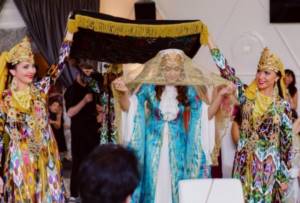
Celebration after the wedding “Kelin salom”
“Kelin salom” is the final touch of an Uzbek wedding. The direct translation of this name means “greeting the daughter-in-law,” when the next morning after the wedding the groom’s relatives come to the groom’s house, and the newlywed herself comes out to the guests in a national costume and greets them with bows. But she bows for a reason: for this, the young wife receives gifts from the groom’s parents and other relatives. According to tradition and depending on family closeness, the newlyweds are given everything they need for family life: furniture, carpets, household appliances, jewelry.
Greeting the bride - a beautiful Uzbek tradition
On the third day of the wedding celebration, an important wedding ceremony is supposed to be performed - “Kelim salom”. In the morning, the young wife meets guests and relatives at her husband’s house. The girl bows deeply to everyone who comes, and the guests in return present her with various gifts. They give everything that may be useful for living together:
- carpets,
- furniture,
- Jewelry,
- kitchen utensils,
- rubble equipment.
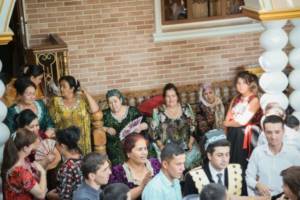
Until this moment, the bride is considered a guest, and after “Kelim Salom” she becomes part of the new family. The third day of the celebration is also celebrated with a richly laid table, music and dancing. This is where the wedding in Uzbekistan ends!
National Uzbek customs for a wedding
Before the imam declares the young spouses, they stand on a bright patchwork blanket, and friends and relatives walk around them with candles, driving away “evil spirits” with fire. The groom then eats the honey and gives it to the bride. The newlyweds must look into the new mirror and both will be reflected in it.
A tablecloth with sweets is spread in front of the newlyweds. This concludes the pre-wedding ceremony.
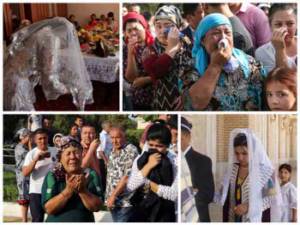
Ritual of farewell to the bride and parents
To this day, brides from Uzbekistan follow this tradition. After registering the marriage, the husband brings his wife to her parents to say goodbye, where she remains until the next morning. This is a sad moment for the family. Relatives cry because their daughter is leaving her parents' home, and at the same time wish her great happiness in her family life.
Wedding feast and national dishes
On the day when the husband takes his wife from his parents and brings him into his family, the wedding celebration begins. Previously, celebrations were held at the groom's house. Now in Uzbekistan, weddings are more often held in restaurants, as is done in other countries.
A large number of guests are invited to the wedding, sometimes exceeding 500 people. It is mandatory to prepare a special wedding pilaf. Guests give the newlyweds gifts and money. A day of great celebration, when guests have fun, wish the newlyweds happiness, dance and sing Uzbek songs.
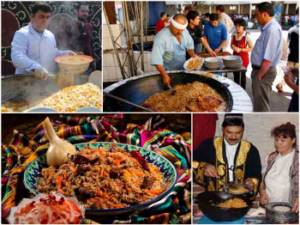
Cooking pilaf
Pilaf is a must at an Uzbek wedding. Wedding pilaf is prepared according to a special recipe, and not every cook is ready to take on the preparation. They invite masters of their craft - oshpazov, even if the celebration takes place at home.
Honey treats at an Uzbek wedding
Uzbek wedding tables always contain a lot of food. Fruits and sweets, including honey, are required. A common delicacy is halva made with honey, honey baklava, and a dish made with honey, chak-chak, began to appear. Although the latter is more typical for Tatar weddings.
Traditions and customs of an Uzbek wedding
Traditions and customs of an Uzbek wedding
The birthday of a new family is one of the brightest, most significant events in the life of two loving people who have decided to unite their destinies. And so that this celebration forever leaves a mark in the hearts of not only the newlyweds, but also their guests, it is celebrated with special pomp.
One of such weddings in the national cultures of the world is the Uzbek wedding. An outstanding, authentic Uzbek wedding with ancient rites and ceremonies will make an indelible impression on the young couple and guests. The wedding celebration takes place over several days with a magnificent feast, songs and dances. A traditional Uzbek wedding is associated with various customs and rituals. Each subsequent ritual follows from the previous one and cannot be skipped.
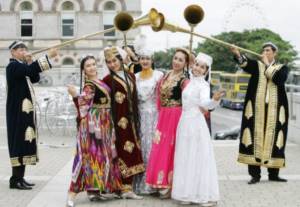
The search for a future spouse and the matchmaking process
An Uzbek wedding differs from a Russian one in its rituals. The bride is the girl who has a special character. Her search is carried out by professionals in the form of a grandmother, mother or older sister.
When selecting a candidate, the situation in the girl’s family is taken into account. Priority is given to those women who grew up in a full-fledged and prosperous family. Parents should be honored and respected. The key points when choosing a future spouse are social status and upbringing. Since ancient times, it was believed that in order to strengthen relationships and raise the social status of the family, the groom was tied by marriage to the family that has a high status.
A man can start looking for his future wife himself. Only love and passion take last place. Despite this, the final choice remains with the man’s parents.
If the choice of son suits the elders, then they begin the matchmaking process. The matchmakers go to the future wife's home. The date is set in advance so that the bride's family can prepare for the event. After the matchmakers have arrived, they are seated at a table, at which a conversation takes place between the elders on various topics. While drinking tea, a young girl takes care not only of her betrothed, but also of the guests. She must ensure that tea is always poured and that the invited guests remain happy and fed.
During the conversation, matchmakers pay attention to several things in the form of:
- home decoration;
- tidiness and order;
- the bride's good behavior;
- meekness and laconicism;
- ability to manage housework;
- relations between parents;
- the relationship of elders to their daughter;
- relations with guests.
The decision about the wedding is made only after the third visit. Then the elders of the future wife share the cake. This sign symbolizes a positive decision to give your daughter in marriage. First, a traditional engagement is held, which is called Fatiha-Tui. The celebration is characterized by pomp. Many guests are invited. The girl is given gifts and sweets by the groom. Then the Uzbek wedding takes place.
Uzbek wedding: customs and traditions
A special scope and observance of many traditions are the main distinguishing features of a truly colorful Uzbek wedding. How it differs from the European one and what its features are, this is what the Svadebka.ws portal is in a hurry to tell you.
